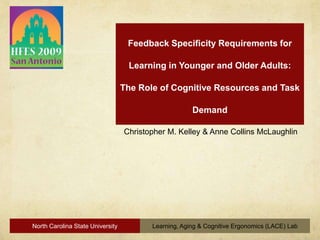
Kelley & McLaughlin, 2009
- 1. Feedback Specificity Requirements for Learning in Younger and Older Adults:The Role of Cognitive Resources and Task Demand Christopher M. Kelley & Anne Collins McLaughlin North Carolina State University Learning, Aging & Cognitive Ergonomics (LACE) Lab
- 2. Definitions Research The Study Overview
- 3. Feedback
- 4. Performance vs Learning (Brosvic, Dihoff, Epstein, & Cook, 2006; McLaughlin, 2007; Salmoni, Schmidt, & Walter, 1984; Schmidt &Bjork, 1992)
- 8. Conceptual Directive Rare Every Trial Lengthy Delay Immediate LOW HIGH SUPPORT Content Frequency Timing
- 9. Research
- 10. Feedback (Support) Present No Feedback Acquisition Retention Feedback/Support Condition Results Results Mixed Increased performance High LEARNING Mixed Decreased performance Low Cog. Resources Task Demand
- 11. Learner Characteristics Task Load High Ability Younger Adults Prior Knowledge Simple or Easy Tasks Low Feedback Support Best Level of Support Low ability Older Adults Special Pop Low knowledge Complex or Difficult Tasks High Feedback Support
- 12. Balance Task Demands Cognitive Resources Feedback =
- 13. Who
- 14. Cognitive Resources Young Adults & Older Adults
- 15. Cognitive Resources Working Memory (Engle, Kane &Tuholski, 1999 )
- 16. How
- 17. Task Demands Simple Task
- 18. What Task?
- 19. Windows Pop-ups 2 Cues
- 20. Cue 1
- 21. Cue 2 Tone Grammar
- 22. Is this really a simple task?
- 23. The Study
- 24. Research Question What are the feedback requirements for older and younger adults learning a simple cognitive task?
- 25. Hypotheses Age will interact with feedback support level, where older adults will require more support than younger; in addition, younger adults should learn more with less support compared to younger adults given more feedback support in acquisition
- 28. Acquisition
- 31. Feedback
- 32. Low
- 35. Low Feedback
- 36. High Feedback
- 37. Results
- 38. Preliminary Results Participants: 38 Younger Adults and 42 Older Adults 2 (Feedback: low, high) x 2 (Age Group: Younger, Older)
- 39. Preliminary Results Main effect of feedback Main effect of age Session x Age interaction
- 40. Performance
- 41. Performance by Age & Feedback * * * *p < .05
- 42. Conclusion Participants that received high feedback out performed those in their age group receiving low feedback What is a simple cognitive task?
- 43. Acknowledgements This research was supported by a grant from North Carolina State University’s Faculty Research and Professional Development (FRPD) fund under the auspices of the Office of Research and Graduate Studies The Learning, Aging, and Cognitive Ergonomics Lab at NC State University www.lacelab.org North Carolina State University Learning, Aging & Cognitive Ergonomics (LACE) Lab
Notas do Editor
- Feedback is information from an external source about performance meant to guide learning. Feedback has various roles. It can be used to inform the learner of correct responses, or to increase motivation and to help energize the learner.
- performance can be viewed as temporary transient effects, or what an individual does in an activity while Learning can be defined as a permanent change in the ability of an individual
- Here are three parameters for feedback generally manipulated in feedback research to provide more or less support. The first is content, which studies generally measure as the units or type of information in the feedback. Frequency has generally been examined as being absolute, meaning the total number of trials with feedback, or relative, meaning the percentage of total trials with feedback. Timing of feedback indicates the amount of delay between the action and feedback on that action. For example, taking a test and receiving a grade a week later would be feedback with a 1 week delay.
- Feedback studies have generally looked at feedback in terms of “more” or “less” information. However, more or less information doesn’t always correspond to more or less support. So, what we really mean is more or less instruction, or guidance for the learner.
- These parameters have generally been studied by placing them on a spectrum and comparing the extremes. (PRESS)For example, feedback content has been compared by giving conceptual feedback about a system or directive feedback about correct actions. Feedback frequency has been compared from rare or once at the end of training, to feedback every trial.Timing has been compared with many different delays between action and feedback. You can think of these parameters as being set to some point between their extremes (PRESS).I’ve created a label called support (PRESS) that captures the way these feedback parameters have been manipulated. If you think about the low side of the spectrum offering less SUPPORT for performance and the right side offering more… it helps to organize the feedback literature. (PRESS) I’ll get more into how this organizes the findings in a minute.“Common sense” might suggest that giving High support during acquisition and thereby making the learner appear to demonstrate more accurate performance at that time would result in better learning. This is not the case.MOST researchers currently agree: setting any of these parameters toward the low side tends to reduce perf. in acq but increase performance after a retention interval and on transfer tests. This is called the paradox of transfer and retention.
- One way to test this theory is comparing samples of populations with known differences, older and younger adults
- Working memory capacity is the amount of attentional processes available to an individual as well as the ability to focus and allocate these processes, or the simultaneous processing and storing of information.
- A Complex task can be defined as a task with many interacting elements, while a task difficulty can be thought of as the ease in which a task is accomplished.We can debate the difficulty of the task, but we wouldn’t classify this as a complex task.
- -Manipulation check-More > less FB-YA> OA